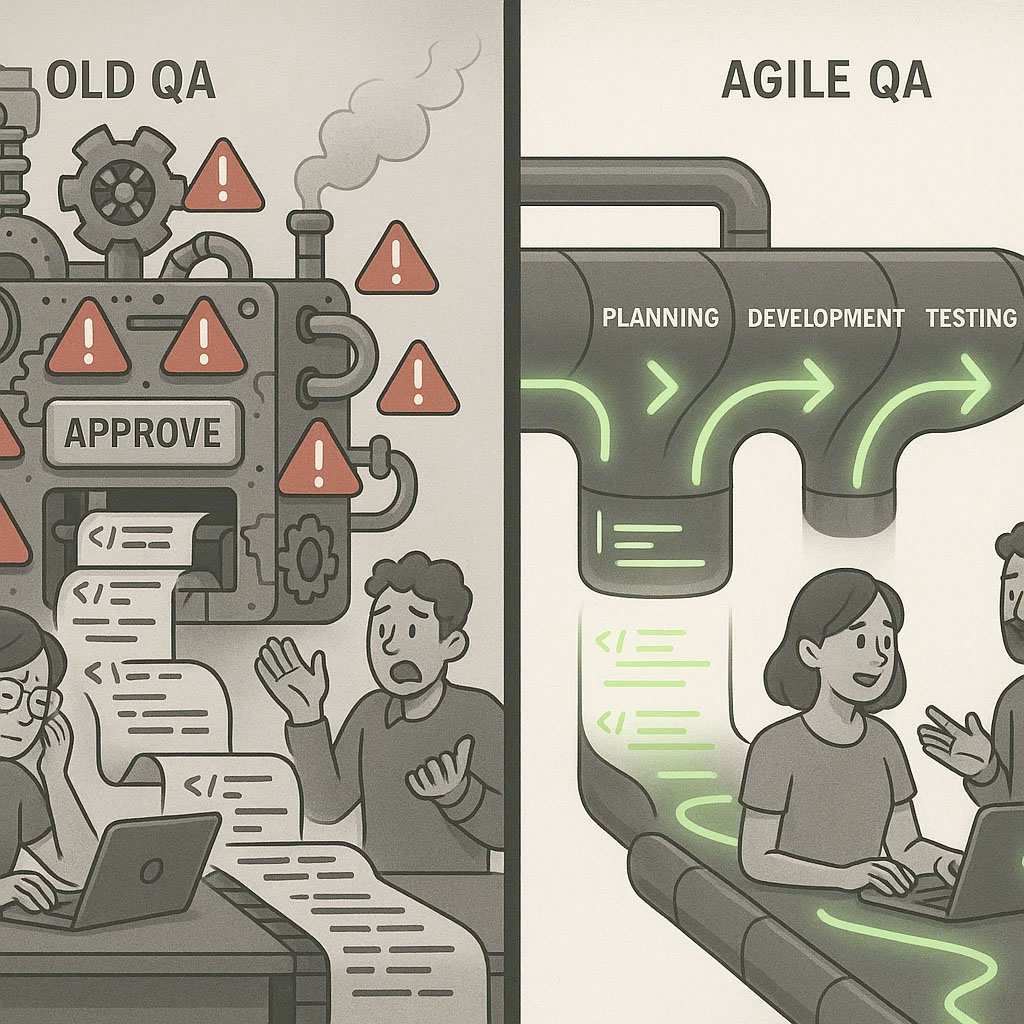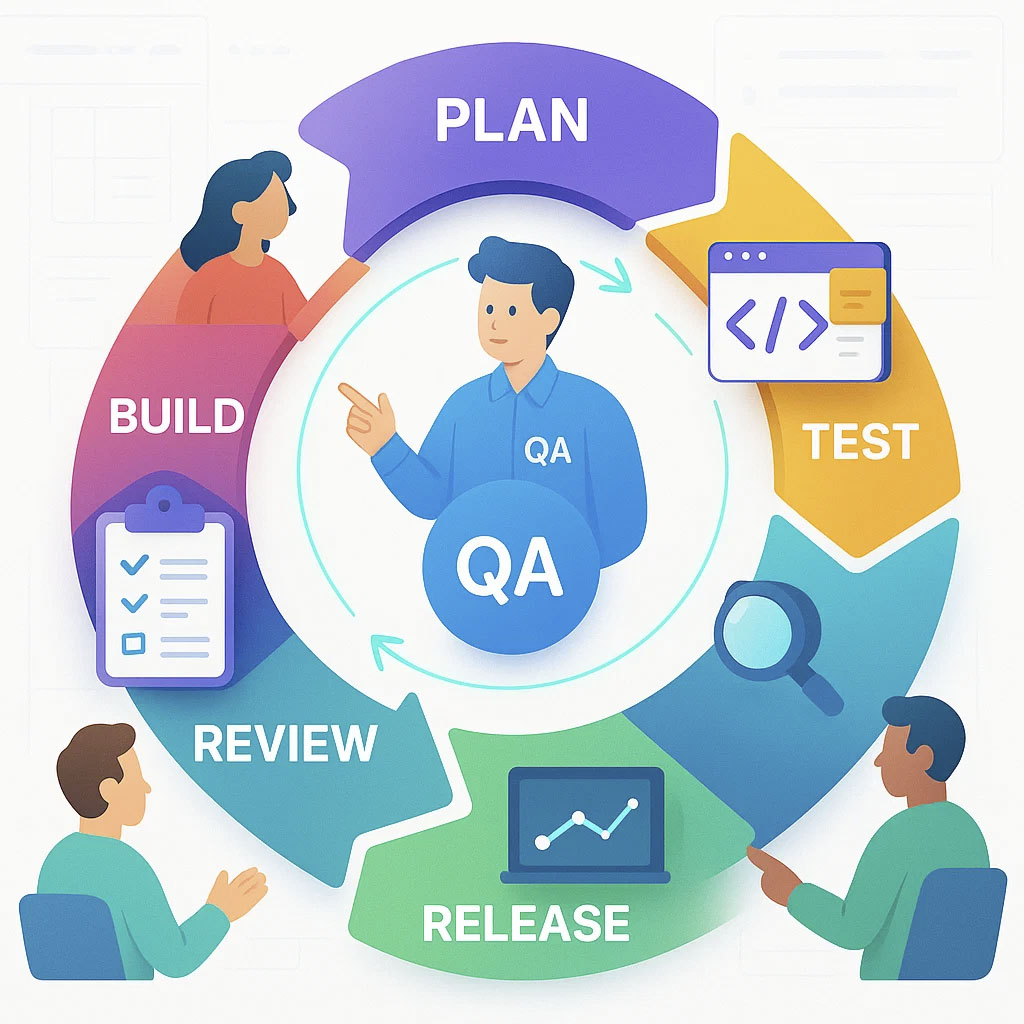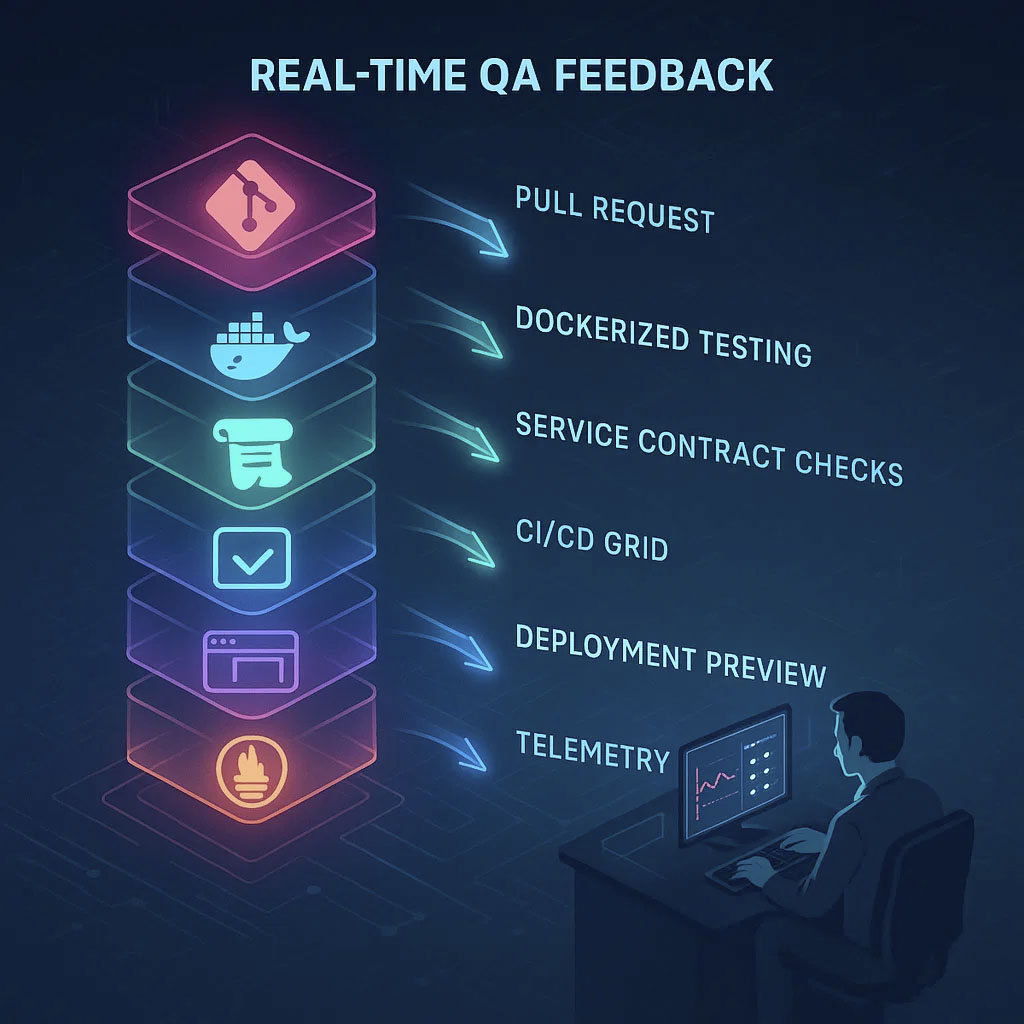Introduction
Short answer
Rigid QA causes bottlenecks. Agile QA adapts to fast-paced development and focuses on preventing issues early.
Common Issues with Traditional QA:
Delayed releases due to long regression cycles.
Developers idle while waiting for QA.
Bugs slipping into production.
Agile QA Solutions:
Shift-left QA: Involve QA from sprint planning.
Real-time feedback: Use CI/CD to detect issues immediately.
User-first focus: Prioritize what truly affects UX.
A developer pushes out a quick fix to the login process. It seems to work fine. But it won’t be live for another couple of days because it’s caught up in a slow regression cycle. While the QA team catches up, the developers are just waiting, the support team is running around trying to keep things together, and the customers are waiting for the fix. This is how a lack of Agile QA looks like in reality.
It’s a process breakdown — and surprisingly common.
When QA is too rigid, it not only slows things down, it damages confidence, throws schedules off course, and forces businesses to decide between speed and security. However, there’s a better approach: Agile QA. Testing should change together with your code, not after the fact.
In this piece, we’ll explain what QA flexibility actually involves, why it’s so important these days, and how to include it in your workflow without new tools or spending tons of money.
Understanding Agile QA flexibility

Agile development requires a quick QA process.
QA flexibility means your testing changes along with your code, not later. Quality assurance becomes part of each sprint stage, catching bugs early. This keeps feedback flowing and lets teams move quickly with confidence.
Flexible QA in action
- Shift-left QA. QA gets involved in sprint planning, not just at release.
- Real-time feedback. CI/CD pipelines show problems as soon as they appear.
- Customer-first thinking. Focus on what harms the user experience, not just meeting basic requirements.
Passing all tests is pointless if the one broken function is what users depend on.
QA role in a sprint
Short answer
QA supports every sprint phase — from planning to release — to ensure quality evolves with the product.
QA Touchpoints:
Planning: QA flags risky scenarios early.
Development: Write BDD-style tests alongside code.
Review: Attach test feedback to PRs.
Release: Monitor post-release user behavior.
Here’s how QA participates in each phase.
- Planning. Work with developers to find unusual situations.
- Development. Create BDD-style tests while features are coded.
- Review. Share test feedback in each pull request.
- Release. Connect test results to user experience through monitoring tools.
Changing to flexible QA is more than just changing processes. It’s about a new way of thinking. Quality becomes a team effort — guided by quick feedback and user results.
How to make Agile QA more flexible with developer-led techniques

Short answer
Developers play a key role in QA by creating testable, reliable, and modular code from the start.
Developer-Led QA Practices:
API-first test logic: Simple, scalable tests (e.g., Cypress BDD).
Risk-based test priorities: Focus on core flows, not edge cases.
Test planning at design stage: Bake quality into feature specs.
Realistic simulations: Reflect actual device types, speeds, and usage conditions.
To make quality assurance more flexible, focus on developing improved habits rather than just getting more tools.
Developers are very important in this process. Quality assurance should be integrated into your code and planning from the beginning, so it’s simpler to move quickly while maintaining assurance. Here’s how it works.
Actionable strategies for achieving flexible quality assurance
- Create API-focused, quick tests.
Concentrate on simple, easy-to-maintain test logic that scales well.
// Cypress BDD example
Given(user is logged in, () => {
cy.login();
});- Prioritize by importance, not routine. Concentrate on what’s most crucial.
It doesn’t matter if the 404 page works, but it’s very important that the checkout process does.
- Plan tests during the design phase. Quality assurance should not be an afterthought. Make it a part of the initial planning, so test cases accurately reflect real-world situations from the start.
- Replicate actual user actions. Ensure tests accurately reflect reality.
- Slow mobile connections
- Different device and browser setups
- Inconsistent or unreliable processes
Reference for developer strategies
- Test architecture that puts APIs first
- Prioritizing tests based on risk
- Planning quality assurance during the story design
- Simulated user procedures that are realistic
The aim isn’t to test everything, but to test the most vital things correctly and at the appropriate time. This allows you to progress rapidly without causing errors.
Give your process a boost. Use tools and infrastructure that make Agile QA smooth
Short answer
Fast pipelines and dynamic test environments enable smooth, scalable QA.
Infrastructure Elements:
CI/CD pipelines: Auto-trigger critical tests.
Ephemeral test environments: Use Docker + Terraform.
Service contract testing: Validate API integrity with tools like Pact.
Telemetry tracking: Use OpenTelemetry, Prometheus, and Grafana for live QA data.
Feedback Pipeline Example:
PR → Docker setup → Contract tests → CI grid → Deploy preview → Telemetry → Production insights
A great plan needs good systems to work. Flexible QA needs fast infrastructure that can change easily.
Here is how to support QA that matches your speed of coding.
Main infrastructure parts
- CI/CD pipelines with test triggers that adapt. Run only what is important — save time.
- Short-term test setups. Use Docker + Terraform to quickly create test setups when needed.
- Service contract tests. Tools like Pact make sure APIs don’t break as you change microservices.
- QA tracking. Track test coverage to production using OpenTelemetry, Prometheus, and Grafana.
Feedback flow
PR goes to Docker test setup, then contract test, then CI grid, then deploy preview, then Telemetry.
Every commit should give you feedback, and every test should link to what users experience.
Views that keep teams in sync
- CI checks. Quick feedback on pass or fail.
- PR notes. Show test quality and how often tests fail right in code reviews.
- Sprint boards. Show QA time and stability.
Do not wait for a QA report each week. Show information on where teams make choices.
Make it cultural. Agile QA roles and behaviors that enable flexibility

Short answer
Tools help, but team mindset drives flexible QA. Quality must be a shared responsibility.
Before vs After:
Stage
Traditional QA
Agile QA
Planning
QA excluded
QA involved from the start
Sprint End
Testing begins
Tests run continuously
Accountability
QA owns quality
Shared by devs and QA
Best Practices:
QA coaches instead of gatekeepers.
Developers contribute to test writing.
Regular bug hunts and retrospective reviews.
Sure, tools are useful, but they’re not the whole story. To really have QA that can bend and flex, it gets down to your team’s attitude toward quality — and who’s actually in charge.
The old QA way is like when coders code, and QA tests later on. Then, bugs pop up after release. Not ideal.
Agile QA changes things, just look at the difference.
Before
- Coders just toss the code to QA.
- QA tests after the sprint is done.
- Bugs make it live.
After
- QA is part of planning.
- Tests run with every change.
- Releases go smoothly.
So, what does an updated QA scene look like?
QA is like a coach, not a bouncer. They help make smart choices about quality, instead of simply approving or rejecting.
Coders share responsibility for quality. Creating, keeping up with, and fixing tests becomes something everyone does together.
Team-based QA routines
- Bug hunts
- Time set aside for exploring tests
- Reviews that talk about both good quality moments and where things fell short
For us, the true move forward happened when QA got a seat at backlog grooming — not when some fresh tool was brought in.
Updating your approach isn’t about getting more QA folks. It’s about making quality part of everyone’s job.
Keep tabs on what’s important. Agile QA measurements should show speed, stability, and influence
Short answer
Agile QA metrics should reflect speed, reliability, and impact on users.
Developer-Centric Metrics:
Feedback time: Time from PR to test result.
Unreliable test rate: Aim for <5% flakiness.
Customer-Focused Metrics:
Escaped defects: Bugs reaching production.
Emergency patch rate: Urgent post-release fixes.
Delivery Speed Metrics:
QA time per story: Total QA time/story.
Average fix time: Speed of resolving test failures.
Test stability score: Pass rate × (1 – failure chance).
Tip: Display metrics in PR notes, dashboards, and Slack alerts — not hidden in spreadsheets.
Real Examples of Flexible QA in Action
SaaS Company:
Issue: 3-day regression cycles.
Fix: CI pipelines + Cypress + XRay.
Result: Test time reduced to 3 hours.
Fintech Startup:
Issue: Onboarding bugs hurt conversion.
Fix: Shift-left QA + Pact contract testing.
Result: Onboarding defects dropped by 27%.
HealthTech Team:
Issue: Frequent rollbacks from edge cases.
Fix: Feature flags + telemetry insights.
Result: 40% fewer production rollbacks.
You can only make things better if you keep track of them — but not every measurement is worth following.
Agile QA requires useful measurements. These tell you about problems early, show the real effect on customers, and guide teams to smarter shipping.
Developer measurements: How quick and steady is feedback?
- Feedback time. Time from submitting to test outcome.
- Unreliable test rate. Keep it under 5% to avoid confusion.
Customer-focused measurements: How does QA change what users experience?
- Defects that got through per release. Problems that reach live users.
- Emergency patch rate. How often do you fix things outside the normal release schedule?
- Help requests related to test errors. Shows where missing checks hurt the most.
Shipping measurements: How Agile QA impacts team speed
- QA time per story. Time from starting a story to confirming test coverage.
- Average fix time. How fast your team resolves broken processes.
- Test steadiness score. How to figure it out: Pass rate × (1 – failure chance).
A key UX point to remember
Measurements only matter if they’re part of how you work.
- Show them in code change notes
- Display trends in charts
- Set up notifications based on live data
If not, they’re just numbers on a spreadsheet that nobody looks at.

Here are some real-world examples of Agile QA flexibility
Top-notch QA changes come from a change in how you think. It can be useful to see how other teams approached this shift.
These examples show how three teams made QA flexibility a reality, along with what they learned.
Big SaaS company
- Issue. Regression testing took three days, which blocked releases.
- Plan. Used a CI pipeline that tested at the PR level with GitHub Actions, Cypress, and XRay.
- Outcome. Test cycles went down to three hours.
- Lesson. Automation and getting QA involved early on speed things up.
Fintech startup
- Issue. Bugs in onboarding hurt first impressions and user activation.
- Plan. Moved QA earlier in the process and used contract testing with Pact.
- Outcome. Bugs related to onboarding decreased by 27%.
- Lesson. It’s better to align tests with important user flows than to aim for total coverage.
HealthTech team
- Issue. Frequent rollbacks were needed because of untested edge cases.
- Plan. Used feature flags and tracked actual usage patterns.
- Outcome. Production rollbacks decreased by 40%.
- Lesson. Observing real usage turns QA into a way to get feedback, not just a task list.
We didn’t fix QA by just automating more. We fixed it by making testing relevant to what users actually do.
Agile QA is about learning faster, getting better feedback, and releasing updates with more confidence each time.
Conclusion: QA flexibility is really important in Agile
Key takeaways
Agile QA is about fast, relevant feedback and shared quality ownership. It’s a mindset shift — not just a tooling upgrade.
To Succeed:
Involve QA early.
Write modular, API-based tests.
Integrate QA with CI/CD.
Track useful metrics.
Make quality everyone’s job.
QA isn’t a blocker — when done right, it’s your competitive edge.
If you want to build quickly, you can’t have QA that’s too strict.
Flexible QA helps teams:
- Ship code faster, without getting bogged down in old problems
- Make engineering, product, and support trust each other
- Have fewer outages and release with more confidence
- Make customers happier by fixing bugs and keeping things running smoothly
And you don’t have to totally redo your QA.
You will need:
- To get QA going early, starting when you plan
- To design tests in a modular, API-first way so they’re quick and easy to keep up
- Feedback as fast as possible, from code to deployment
- Clear metrics that show you how to make things better
- A team that takes responsibility for quality together
The best QA changes aren’t about getting a new tool; they’re about sharing the work and getting feedback fast.
QA shouldn’t slow you down. If you make it flexible, it can give you an edge.
By Egor Kaleynik
IT-oriented marketer with B2B Content Marketing superpower. HackerNoon Contributor of the Year 2021 Winner – MARKETING. Generative AI enthusiast.
Featured in: Hackernoon.com, Customerthink.com, DZone.com, Medium.com/swlh
More info: https://muckrack.com/egor-kaleynik
Credibility Hub
